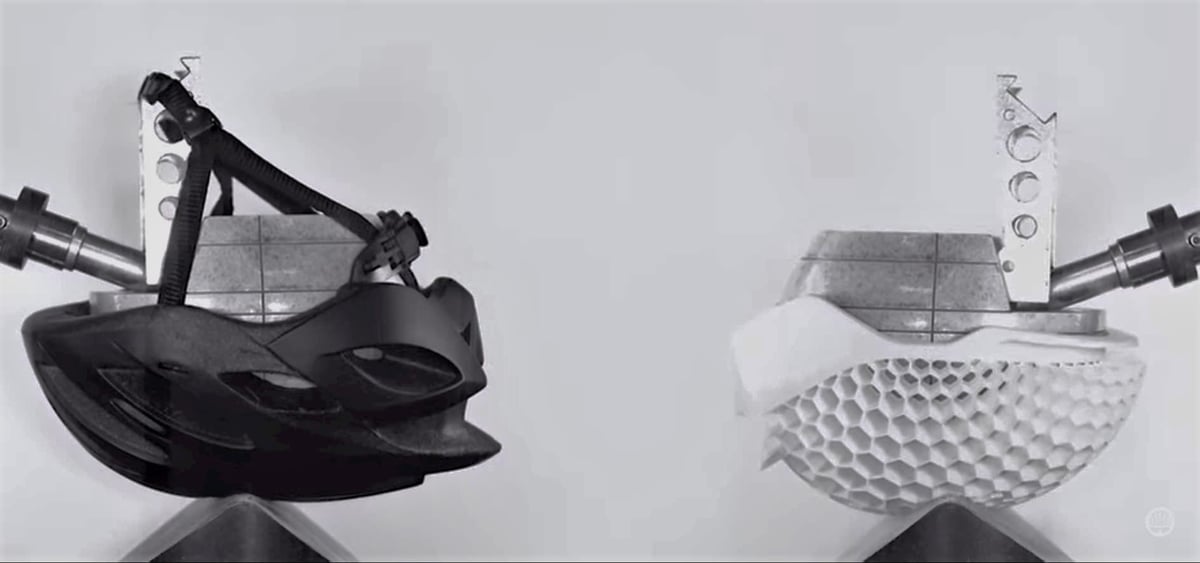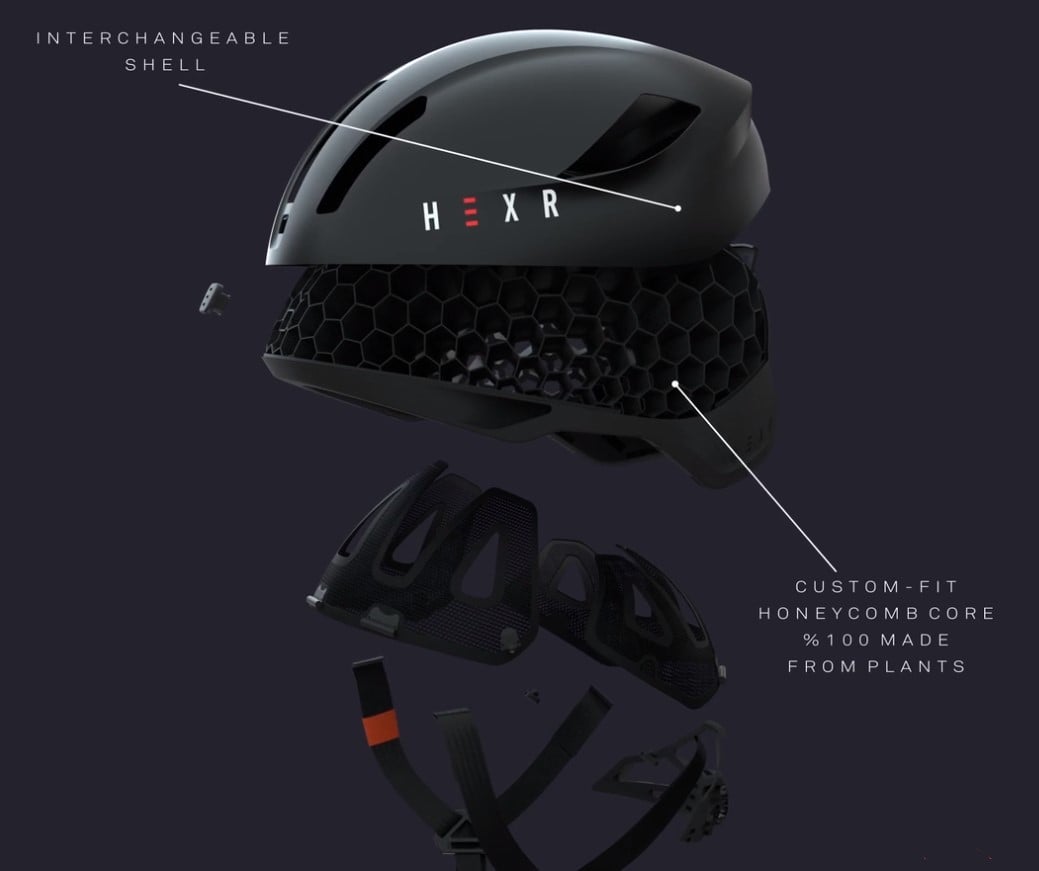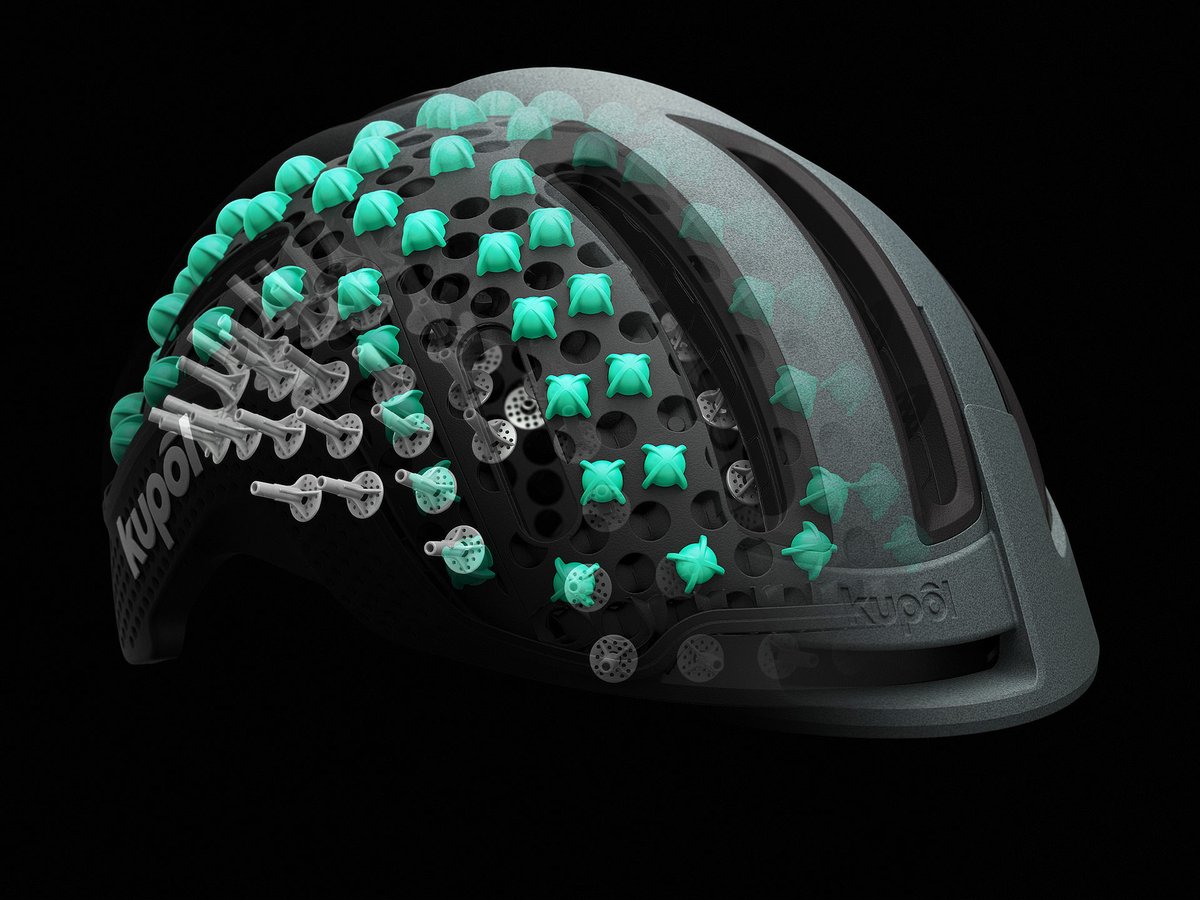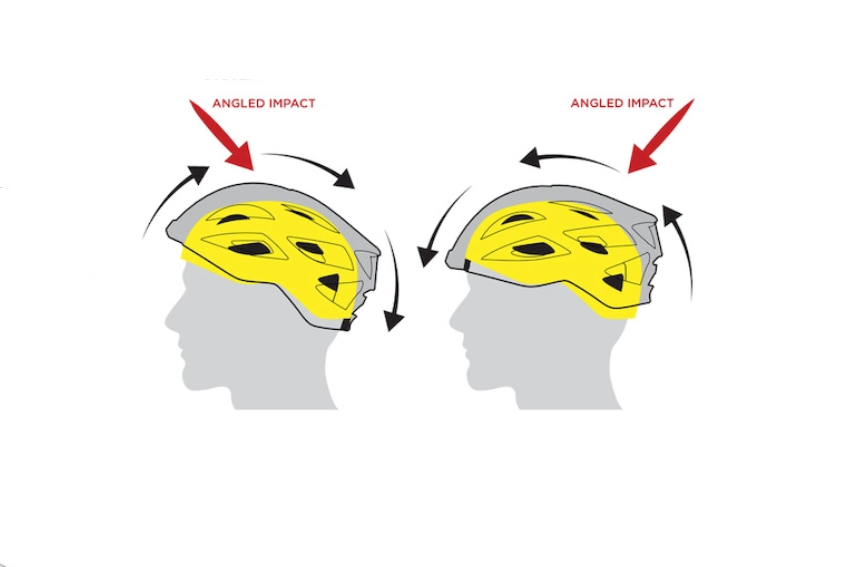Safety in Mind

Helmets are incredible safety devices. They can prevent you from getting seriously injured in the event of an accident, and they’ve most certainly saved countless lives. In order to be effective, helmets have to be able to absorb and deflect energy. They do this by using suitable materials and proper design.
Lately, many people have been wondering if it’s actually possible to 3D print a bicycle helmet. The answer is yes it is, but printing one that’s safe to use is another story, even if it fits well and looks similar to a functional one. In other words, printing one off with your Ender 3 won’t do the trick – not for the foreseeable anyway. You’ll need to refer to a professional to get the job done.
Remember, only ever use certified safety equipment as protective gear. That applies to helmets too, no matter how good they may look!
In this article, we’re going to look briefly at what constitutes a good and safe helmet and then show you a couple of pioneering companies that are using 3D scanning (pictured above) and industrial 3D printing machines to bring 3D printed helmets to life. We’ll end with a quick summary of the two makes.
If, while you’re checking out this article, you think that you’d like to have a print custom-made because you don’t have the necessary set-up or technical know-how, another option is Craftcloud by All3DP. This is also a very helpful tool for sourcing local manufacturers in your area.
Now, sit back and enjoy the ride!
Safety Standards

What qualities does a good helmet need for it to be effective? For starters, you’ll need to make sure it’s been tested and proven safe for wearers. Traditionally, manufacturers test their helmets for effectiveness in two areas – shell deflection and rotation as well as shock absorption.
Shell Deflection & Rotation
Shell deflection is the first line of defense that a helmet provides. A good helmet is designed in such a way that if it makes contact with an object, it’ll bounce away from it at a safe angle. However, in the event that the impact is too great, shell deflection will give way to shock absorption.
If there’s a heavy impact, the brain and neck are at risk of being injured. Some higher quality helmets use the patented multi-directional impact protection system (MIPS) that allows the outer shell to absorb the brunt of the shock while the inner layer rotates (rather than the user’s head) to help deflect the rest of the impact.
Shock Absorption
If the skull is hit hard enough, the brain inside will bounce around and can incur serious damage. A good helmet should soften and absorb most of the impact force on the skull and brain. This is done by taking the impact force and redirecting it over a wider area, so the force will dissipate rather than being focused all in one place.
Bearing safety factors in mind, the following two companies have designed fully functional and safe 3D printed bicycle helmets. They’ve incorporated their own designs and claim that their helmets are just as good (if not better) at protecting the user from rotational and direct impacts as traditional ones.
Hexr

While traditional helmets are built around standard sizes that, in theory, fit all, Hexr uses specialized 3D scanning modeling and printing procedures in order to precisely measure and accommodate each cyclist’s head shape.
Hexr also upgraded its materials from standard helmets, which are made of expanded polystyrene foam (EPS) that compacts and hardens after impact, lessening its effectiveness the more it’s used. Hexr’s gone through more than six years of tests and crash-tested hundreds of helmets in order to develop a safer product based around each user’s specific needs.
But a custom-fit and better quality materials don’t come cheap! Hexr protects well and for that, their prices start at around £299 ($360), while a good quality (commercial) helmet can be found starting at $45.
Who designed it? Jamie Cook founded Hexr, formerly known as Hexo, after observing energy impacts are different depending upon surface areas. This led him to do extensive research on improving bicycle helmet technology.
How is it made? The Hexr helmet is designed after measurements of the cyclist’s head are taken with a 3D scanner. Once this is done, a honeycomb shell is printed using selective laser sintering (SLS) technology, which forms the main structure of the helmet. The process is extremely precise: It incorporates around 3,500 print layers and takes around 24 hours to complete.
How is it different? Hexr’s honeycomb structures provide personalized security and one of the highest strength to weight ratios, which is great for both deflection and absorbing impact. According to this BikeRadar video review, the company also claims that the helmet is a lot safer than others on the market. Other pluses include it’s light-weight, aerodynamic, cool to wear on hot days, recyclable, and of course, will fit the wearer perfectly.
Why choose it? Hexr’s independent tests indicate that its helmet performs 26% better than many commercially available helmets, and at least 10% better than helmets with MIPS designs. However, standard and MIPS helmets have been used for generations with great results.
Kupol

The Kupol helmet looks amazing, but after an unsuccessful Kickstarter fundraiser in 2018, it remains an ongoing project, and we’re currently waiting for news of its launch. It is, however, a great design.
Directly beneath the shell, there are several layers. First, there are kinetic bumpers that absorb and protect the wearer against medium impacts. Beneath these bumpers is what the designers refer to as the 3D Kore (inner core or layers), which collapse drastically in order to absorb major impact forces.
In the final layer, you’ll find the patented Oktopus pods or density prongs, which are for comfort and function similarly to the design of MIPS helmets by limiting rotational damage.
The helmet was designed purely with bike riders in mind who know what is needed to enjoy riding while staying safe. Compared to conventional helmets, it appears to provide the same, if not higher, levels of protection. The cost has yet to be announced.
Who designed it? Gabriel Boutin is a Montreal-based sports equipment designer that wanted to add a little innovation to the designs of bike helmets, which haven’t changed in over 20 years.
How is it made? Kupol 3D prints the main structure of the helmet with a multi-jet fusion PA 12 in order to make it lightweight, very strong, and durable. It also sports a honeycomb design, which adds to the breathability and low weight of the design. Once printed, the parts of the structure and the other components are fitted together to form the completed helmet.
How is it different? Kupol also uses a hexagonal support structure and bumpers in order to absorb impacts instead of the conventional expanded foam. For it to be comfortable and sized correctly, Kupol offers twice as many sizes compared to other brands and claims the Oktopus pods will give you the perfect fit. The helmet is also customizable, so you can have an MTB (mountain bike) or a road bike helmet.
Why choose it? As we mentioned earlier, Kupol is still in its project phase and isn’t yet available for purchase. However, you can keep an eye on their Facebook page or website for launch details.
See Gabriel talk about the project below:
Final Thoughts

Both of these helmet designs are awesome and we hope that as 3D printing technology advances, we’ll see more exciting projects like these.
Similarities
Both helmets utilize a 3D printed honeycomb structure in order to absorb energy from impacts. Each helmet keeps the traditional shell on the outside and provides a breathable aerodynamic design. They also both claim to be a big improvement on traditional helmets that use EPS shock absorption.
Differences
Hexr’s simplified tailoring and one-print design handles impacts well. It’s this customization that has allowed Hexr to develop some of the most unique custom-design helmets available, rather than a one-size-fits-all approach – but for a price! Unlike Kupol, Hexr helmets are available to buy.
Kupol, on the other hand, has a very complicated multi-layer design that’s geared towards handling both head-on and rotational impacts. These helmets can work very well compared to traditional helmets for everyday bikers and could easily become a fan favorite if and when they become available.
A final heads up
Remember, these two innovations are relatively novel in the world of 3D printing. And, although the products are amazing, they’re still not fully mainstream or easily available.
Hexr and Kupol are professional designers that aim to produce extremely high quality, safe bicycle helmets with industrial-grade equipment. 3D printing a bicycle helmet of your own is not recommended, in fact, we strongly advise against it.
(Lead image source: Cycling Weekly via YouTube)
License: The text of "3D Printed Helmet: The Most Incredible Projects" by All3DP is licensed under a Creative Commons Attribution 4.0 International License.
